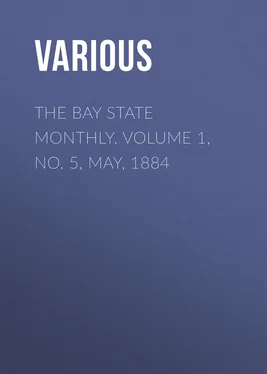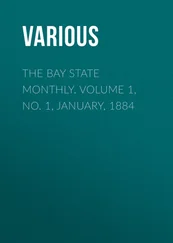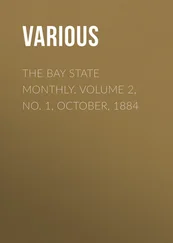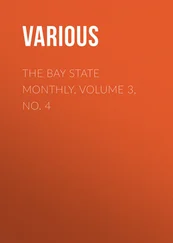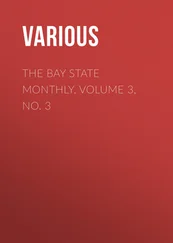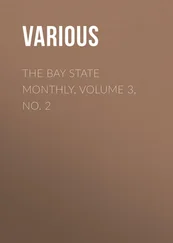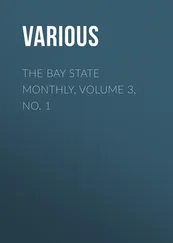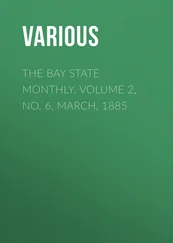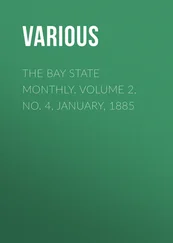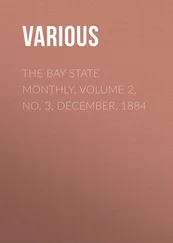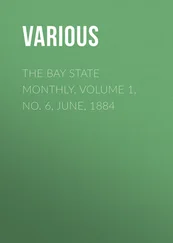Various - The Bay State Monthly. Volume 1, No. 5, May, 1884
Здесь есть возможность читать онлайн «Various - The Bay State Monthly. Volume 1, No. 5, May, 1884» — ознакомительный отрывок электронной книги совершенно бесплатно, а после прочтения отрывка купить полную версию. В некоторых случаях можно слушать аудио, скачать через торрент в формате fb2 и присутствует краткое содержание. Жанр: foreign_antique, periodic, foreign_edu, на английском языке. Описание произведения, (предисловие) а так же отзывы посетителей доступны на портале библиотеки ЛибКат.
- Название:The Bay State Monthly. Volume 1, No. 5, May, 1884
- Автор:
- Жанр:
- Год:неизвестен
- ISBN:нет данных
- Рейтинг книги:4 / 5. Голосов: 1
-
Избранное:Добавить в избранное
- Отзывы:
-
Ваша оценка:
- 80
- 1
- 2
- 3
- 4
- 5
The Bay State Monthly. Volume 1, No. 5, May, 1884: краткое содержание, описание и аннотация
Предлагаем к чтению аннотацию, описание, краткое содержание или предисловие (зависит от того, что написал сам автор книги «The Bay State Monthly. Volume 1, No. 5, May, 1884»). Если вы не нашли необходимую информацию о книге — напишите в комментариях, мы постараемся отыскать её.
The Bay State Monthly. Volume 1, No. 5, May, 1884 — читать онлайн ознакомительный отрывок
Ниже представлен текст книги, разбитый по страницам. Система сохранения места последней прочитанной страницы, позволяет с удобством читать онлайн бесплатно книгу «The Bay State Monthly. Volume 1, No. 5, May, 1884», без необходимости каждый раз заново искать на чём Вы остановились. Поставьте закладку, и сможете в любой момент перейти на страницу, на которой закончили чтение.
Интервал:
Закладка:
But vanished from our wistful sight,
Too late for vain regretting,
The joys, that the remorseful heart
With sacred gold is setting.
Ah! dearest of all earthly hopes
Within the soul abiding,
The lost, lost life of yesterday
The heart is ever hiding.
THE BOUNDARY LINES OF OLD GROTON.—I
The original grant of the township of Groton was made by the General Court, on May 25, 1655, and gave to the proprietors a tract of land eight miles square; though during the next year this was modified so that its shape varied somewhat from the first plan. It comprised all of what is now Groton and Ayer, nearly all of Pepperell and Shirley, large parts of Dunstable and Littleton, smaller parts of Harvard and Westford, Massachusetts, and a portion of Nashua, New Hampshire. The grant was taken out of the very wilderness, relatively far from any other town, and standing like a sentinel on the frontiers. Lancaster, fourteen miles away, was its nearest neighbor in the southwesterly direction on the one side; and Andover and Haverhill, twenty and twenty-five miles distant, more or less, in the northeasterly direction on the other. No settlement on the north stood between it and the settlements in Canada. Chelmsford and Billerica were each incorporated about the same time, though a few days later.
When the grant was made, it was expressly stipulated that Mr. Jonathan Danforth, of Cambridge, with such others as he might desire, should lay it out with all convenient speed in order to encourage the prompt settlement of a minister; and furthermore that the selectmen of the town should pay a fair amount for his services. During the next year a petition, signed by Deane Winthrop and seven others, was presented to the General Court asking for certain changes in the conditions, and among them the privilege to employ another "artist" in the place of Mr. Danforth, as he was overrun with business. The petition was referred to a committee who reported favorably upon it, and the request was duly granted. Formerly a surveyor was called an artist, and in old records the word is often found with that meaning.
Ensign Peter Noyes, of Sudbury, was then engaged by the grantees and he began the survey; but his death, on September 23, 1657, delayed the speedy accomplishment of the work. It is known that there was some trouble in the early settlement of the place, growing out of the question of lands, but its exact character is not recorded; perhaps it was owing to the delay which now occurred. Ensign Noyes was a noted surveyor, but not so famous as Jonathan Danforth, whose name is often mentioned in the General Court records, in connection with the laying out of lands and towns, and many of whose plans are still preserved among the Archives in the State House. Danforth was the man wanted at first for the undertaking; and after Noyes's death he took charge of it, and his elder brother, Thomas, was associated with him. The plat or plan of the land, however, does not appear to have been completed until April, 1668. The survey was made during the preceding year. At a meeting of the selectmen of the town, held on November 23, 1667, it is recorded that a rate should be levied in order to pay "the Artest and the men that attended him and his diet for himself and his horse, and for two sheets of parchment, for him to make two platts for the towne, and for Transportation of his pay all which amounts to about twenty pounds and to pay severall other town debts that appear to us to be due."
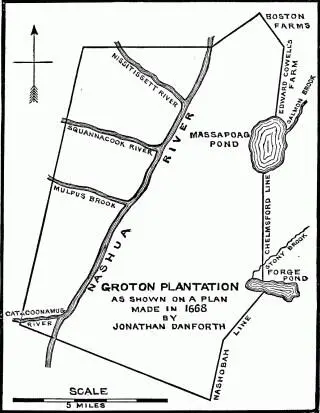
A little further on in the records a charge of five shillings is made 'ffor two sheats of Parchment.' These entries seem to show that two plans were made, perhaps one for the town and the other for the Colony; but neither copy is now to be found. An allusion is made to one of them in a petition, presented to the General Court on February 10, 1717, by John Shepley and John Ames. It is there mentioned that "the said Plat thô something defaced is with the Petitioner;" and is further stated "That in the year 1713 M rSamuel Danforth Surveyor & Son of the aforesaid Jonathan Danforth, at the desire of the said Town of Groton did run the Lines & make an Implatment of the said Township laid out as before & found it agreeable to the former. W hlast Plat the Petitioners do herewith exhibit, And pray that this Hon ble Court would allow & confirm the same as the Township of Groton."
While the original plan has been lost or destroyed, it is fortunate that many years ago a copy was made, which is still preserved. In June, 1825, the Honorable James Prescott was in the possession of the original, which Caleb Butler, Esq., at that time transcribed into one of the town record-books, and thereby saved it for historical purposes. Even with this clew a special search has been made for the missing document, but without success. If it is ever found it will be by chance, where it is the least looked for. There is no reason to doubt the accuracy of the outlines or the faithfulness of the copy. The relative distances between the streams emptying into the Nashua River, however, are not very exact; and in the engraving for the sake of clearness I have added their names, as well as the name of Forge Pond, formerly called Stony Brook Pond.
Accompanying the copy is a description of the survey, which in connection with the drawing gives a good idea of the general shape of the township. Perhaps in the original these two writings were on the same sheet. In the transcript Mr. Butler has modernized the language and made the punctuation conform to present usage. In the engraved cut I have followed strictly the outlines of the plan, as well as the course of the rivers, but I have omitted some details, such as the distances and directions which are given along the margins. These facts appear in the description, and perhaps were taken from it by the copyist. I have also omitted the acreage of the grant, which is grossly inaccurate.
Whereas the Plantation of Groton, containing by grant the proportion of eight miles Square, was begun to be laid out by Ensign Noyes, and he dying before he had finished his work, it is now finished, whose limits and bounds are as followeth,
It began on the east side of Nashua River a little below Nissitisset hills at the short turning of the River bounded by a pine tree marked with G. and so running two miles in a direct line to buckmeadow which p rtains to Boston Farms, Billerica land and Edward Cowells farm until you come to Massapoag Pond, which is full of small islands; from thence it is bounded by the aforesaid Pond until you come to Chelmsford line, after that it is bounded by Chelmsford and Nashoboh lines until you come to the most southerly corner of this Plantation, and from thence it runs West-North-West five miles and a half and sixty four poles, which again reacheth to Nashua River, then the former west-north-west line is continued one mile on the west side of the river, and then it runs one third of a point easterly of north & by east nine miles and a quarter, from thence it runneth four miles due east, which closeth the work to the river again to the first pine below Nissitisset hills, where we began: it is bounded by the Farms and plantations as aforesaid and by the wilderness elsewhere; all which lines are run and very sufficiently bounded by marked trees & pillars of stones: the figure or manner of the lying of it is more fully demonstrated by this plot taken of the same.
By JONATHAN DANFORTH,
April 1668.
Surveyor.
The map of Old Dunstable, between pages 12 and 13 in Fox's History of that town, is very incorrect, so far as it relates to the boundaries of Groton. The Squannacook River is put down as the Nissitissett, and this mistake may have tended to confuse the author's ideas. The southern boundary of Dunstable was by no means a straight line, but was made to conform in part to the northern boundary of Groton, which was somewhat irregular. Groton was incorporated on May 25, 1655, and Dunstable on October 15, 1673, and no part of it came within the limits of this town. The eastern boundary of Groton originally ran northerly through Massapoag Pond and continued into the present limits of Nashua, New Hampshire.
Читать дальшеИнтервал:
Закладка:
Похожие книги на «The Bay State Monthly. Volume 1, No. 5, May, 1884»
Представляем Вашему вниманию похожие книги на «The Bay State Monthly. Volume 1, No. 5, May, 1884» списком для выбора. Мы отобрали схожую по названию и смыслу литературу в надежде предоставить читателям больше вариантов отыскать новые, интересные, ещё непрочитанные произведения.
Обсуждение, отзывы о книге «The Bay State Monthly. Volume 1, No. 5, May, 1884» и просто собственные мнения читателей. Оставьте ваши комментарии, напишите, что Вы думаете о произведении, его смысле или главных героях. Укажите что конкретно понравилось, а что нет, и почему Вы так считаете.
